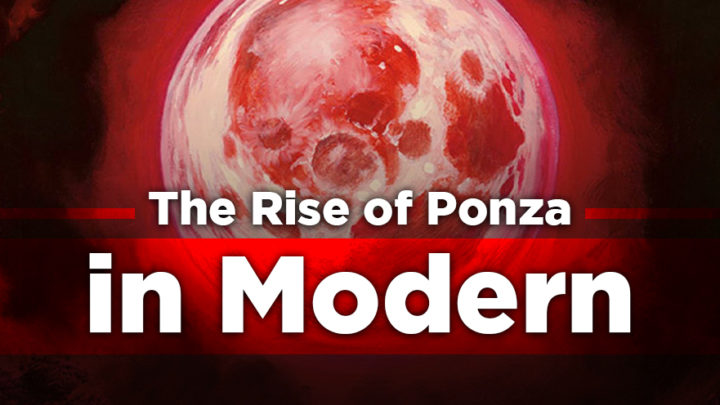For a long time, Ponza wasn’t considered a competitive Modern deck. It emerged in an environment with strong combo decks, where it was often at a disadvantage, and lacked the card quality to keep up with other midrange decks. But now, Ponza — more commonly known as Gruul Midrange — is among the best-performing decks in Modern.
What happened? How did this deck go from meme to supreme? To get to the answers, we’ll need to consider environmental changes, deck-building philosophy, and some fancy new toys the deck picked up along the way.
The Deck

4 Arbor Elf
4 Bloodbraid Elf
3 Bonecrusher Giant
3 Glorybringer
3 Klothys, God of Destiny
2 Scavenging Ooze
4 Seasoned Pyromancer
4 Blood Moon
4 Lightning Bolt
2 Pillage
4 Utopia Sprawl
4 Misty Rainforest
6 Snow-Covered Forest
1 Snow-Covered Mountain
4 Stomping Ground
1 Verdant Catacombs
4 Wooded Foothills
SIDEBOARD
2 Choke
2 Relic of Progenitus
3 Obstinate Baloth
2 Abrade
1 Cindervines
1 Pillage
2 Collector Ouphe
2 Veil of Summer
This is close to a stock Gruul Midrange deck these days; lists rarely deviate by more than a couple cards. This specific list opts for a third Klothys, God of Destiny and a third Chandra, Torch of Defiance over a third Pillage and a fourth Glorybringer — all reasonable changes given the current environment.
Environmental
The long-standing worst match-up for Gruul Midrange is, well…nearly any combo deck. Gruul has never had the raw speed or enough relevant disruption to reliably beat combo. But as pieces like Faithless Looting and Mox Opal were banned, Izzet Phoenix faded away while Dredge, Grishoalbrand, and other graveyard combo decks lost their explosive potential. Mox Opal’s departure also meant that KCI was no longer a player in Modern, and it severely hindered Thopter Foundry + Sword of the Meek and Underworld Breach decks alike.
For most of Modern’s history, there has been at least one good-to-great combo deck. Instead of playing Ponza, midrange pilots would turn to decks like Jund or Grixis Death’s Shadow, which both included much-needed disruption. While Gruul could tangle with some of the other midrange strategies, the prevalence of combo decks made it difficult to justify sleeving up Arbor Elf.

Fragile or greedy mana bases are easy prey for Ponza. Back when Tron was one of the most popular decks in Modern, Gruul was one of the best decks at pressuring its manabase. And now that Arcum’s Astrolabe is out of the picture, things are looking up again for players looking to sleeve up Blood Moon and Pillage. After all, four-color midrange decks are still around and greedier than ever: I’ve seen players try to get away with casting Archmage’s Charm, Supreme Verdict, and escape Uro, all while playing three or more copies of Field of Ruin! While these Bant decks tend to have about six basic lands, a well-timed Pillage or Blood Moon can really hamper their ability to cast spells, especially if Gruul can accelerate with either Arbor Elf or Utopia Sprawl.
Eldrazi Tron is both popular and another good match-up for the Gruul decks — a single Pillage can easily demolish their entire game plan. Given how good Eldrazi Tron’s top end is, it isn’t uncommon for players to keep a hand with Eldrazi Temple and any other land; they likely only need to draw one more land to really hit their stride, and two to be set for the game. If you can interact with Eldrazi Temple on turn two, the results are devastating for the Eldrazi Tron player. Plus, Gruul is one of the few decks in Modern that can trade blows with the monsters that Eldrazi Tron produces.
Deck-Building
Previously, the deck-building philosophy behind Ponza was to maximize mana disruption. But there were some major problems with that plan: What if your opponent slips a threat under your first Stone Rain, or if the game goes long enough for them to draw out of it? In either of those cases, Ponza tended to end up in hot water; any mana acceleration or too much land destruction drawn in the middle of the game won’t have a meaningful impact. Ponza’s power spikes happened at three and six mana, which produced awkward lulls while the opponent was hitting their stride.

Things are different now that Ponza’s line-up has changed. No longer is Gruul packing four Stone Rain, four Pillage, two Mwonvuli Acid-Moss, four Blood Moon and four Magus of the Moon. Instead, they’ve trimmed the fat by cutting all of the Stone Rains, a Pillage, and four of the Blood Moon effects. Current configurations of the deck are full of excellent mid-game cards like Seasoned Pyromancer and Chandra, Torch of Defiance to fill the gaps. Even if you should draw some of the remaining air left in the deck, Seasoned Pyromancer will often be there to bail you out by exchanging your blanks for some 1/1’s and fresh cards.

Given how interactive the format is, you also want to make sure your creatures are going to be worth casting. Creatures that have “enter the battlefield” effects or that are hard to remove will both fit the bill. Seasoned Pyromancer couldn’t care less if it dies; most of the card’s value is in its ETB trigger, and it even comes back from the graveyard for more! Glorybringer will get by Lightning Bolt and Fatal Push, and Path to Exile and Dismember will often give you something in return if your opponent removes it. Bonecrusher Giant provides some interaction while punishing your opponent for killing it.

Green and Red aren’t traditionally known for grinding out incremental advantage, but Ponza has found a way to take the game a little longer. Bloodbraid Elf is a clean two-for-one, and haste creatures tend to gain some value as blue control decks get more popular. (After all Bloodbraid Elf and Jace, the Mind Sculptor are old foes.) But the real value engines in this deck are Chandra, Torch of Defiance, and Klothys, God of Destiny.

Chandra has been the go-to red Planeswalker for midrange decks, and for good reason. The ability to get an extra card or two damage every turn while ticking toward a game-winning ultimate is powerful. And on top of that, she can even minus to handle mid-sized creatures — something Lightning Bolt struggles to do.

Klothys was met with some early skepticism, but it turns out generating extra mana and Shocking your opponent while gaining two life are things Gruul wants to do. It also helps that Gruul can turn Klothys into a creature relatively often, given how many permanents it’s playing now.
Conclusion
Now that it has the right opportunity and the right cards in its arsenal, Gruul can finally hang with the Jund decks of the world in midrange battles. And it’s refreshing to see the deck transform into such a powerful option. One of Modern Horizons’ biggest wins was that it provided historically struggling decks with the tools to be competitive in any metagame.
Are there any other decks that you know of that have gone through similar transformations? Be sure to let me know on Twitter at @RappaciousOne. I’ll be back with more Modern content next week!

Michael Rapp is a Modern specialist who favors Thoughtseize decks. Magic sates his desire for competition and constant improvement.

